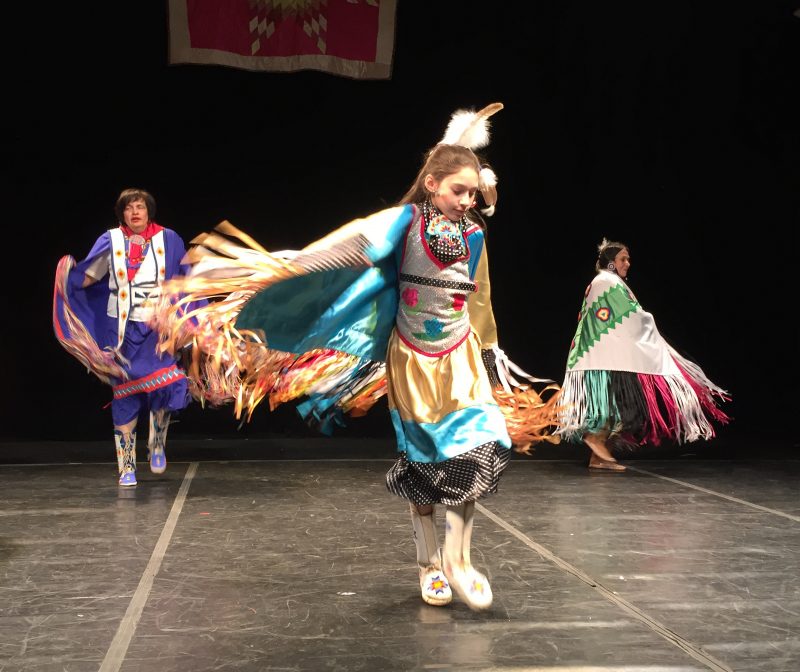When traditions fade, Native Americans dance to remember
(Thomas URBAIN)
New York (AFP) – For 56 years, Louis Mofsie has danced with his troupe, making Native American heritage shine and ensuring that age-old steps live on, even if their tribes of origin may have forgotten them.
Born in Brooklyn 82 years ago, the director of the Thunderbird American Indian Dancers — which he founded in 1963 — is a native New Yorker who only saw Indian reservations on trips out West.
The son of a Hopi from Arizona and a Winnebago from Nebraska, he was still passionate about Native American culture as a young man, quickly looking beyond his tribal ties.
“We went to different reservations, and we danced with the people and we learned the songs and we learned the dances,” recalls Mofsie, who also learned from the large Mohawk community that lived in Brooklyn.
“We put these all together, and then we all came back here to New York. And it kind of grew from that,” he explained.
The goal at first was to “bring those different styles of dancing to New York so people here have an opportunity to see these — without having to travel all over the Southwest.”
These were purely social dances, since ritual or sacred dances traditionally are not to be danced or even seen by anyone outside a tribe.
Though he carefully avoided that pitfall, Louis Mofsie had “troubles” early on.
“Real troubles, because he wanted to share the Indian culture with a large audience and some people in his community were opposed to it,” says Crystal Field, Artistic Director of Theater for the New City, where the Thunderbird performs every year.
“Every culture that’s oppressed draws into itself and then you are the enemy. They’re protecting themselves that way.”
Sometimes inter-tribal, often presented at pow wows, large community gatherings, Mofsie’s chosen dances focus on nature, mainly wildlife, such as the Robin dance, which celebrates the arrival of spring.
The step is often supple, even airy, like a series of bounces alternating to the rhythm pounded out by percussion instruments and songs.
It’s not a couple’s dance, even though women and men practice; the sequencing recalls a bit of swing, or even traditional rock, which has the same fluidity.
Louis also fondly remembers his meeting with the famous American choreographer Martha Graham and his Mexican counterpart Jose Limon.
“Many of their dances were influenced by native American dances,” he says.
– ‘Make leaps’ –
In the series of shows each year by the Thunderbird at the Theater for the New City, an institution in Manhattan’s East Village, Mofsie takes care to contextualize the dances, which if they are not sacred, make sense.
“The important thing for us, too, is to explain what all these dances are, what they mean, because what people have seen on television and movies just looks like a bunch of people jumping around,” says the octogenarian who still leads a troupe of 20 dancers.
“These dances all have an origin, stories that are part of it. That’s important to us, too.”
The old dances intermingle steps that evoke the history of Native American people and their struggles with the white men altering their way of life forever.
One of them refers to the federal government’s forced assimilation policy from the 1870s to the 1960s, which sent thousands of Native American children to boarding schools outside reservations.
Mofsie is delighted to see more people who are deeply interested in Native American culture, as evidenced by the series of shows that was packed.
But he is more concerned today about the preservation of this cultural heritage, which he knows is fragile.
“Some of these dances, I think, they’re no longer” danced. “I think it’s important for those dances to be kept alive so that’s what we’re doing,” he told AFP.
Mofsie would like them to be cataloged and documented in video, for generations to come.
He collaborates with the American Indian Community House, an inter-tribal organization based in New York, which has a large collection of documents.
But so far nobody has sought to inventory the dances fully, including in images — not the AICH or the National Museum of the American Indians, part of the Smithsonian Institution in Washington.
A specialist in Native American heritage at Washington State University, Lotus Norton-Wisla, who helps community organizations in their archival work, says he has never heard of such a project.
Mofsie thinks about the troop, which is getting older, even though some young people have joined him.
“With the influences that young people have today with television, ipods, and everything else, it’s very hard to keep this going,” he said.
Disclaimer: Validity of the above story is for 7 Days from original date of publishing. Source: AFP.


